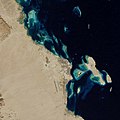Պատկեր:Establishing El Gouna (2014).jpeg

Նախադիտման չափ՝ 600 × 600 պիքսել։ Այլ թույլտվությաններ: 240 × 240 պիքսել | 480 × 480 պիքսել | 768 × 768 պիքսել | 1024 × 1024 պիքսել | 1362 × 1362 պիքսել.
Սկզբնական նիշք (1362 × 1362 փիքսել, նիշքի չափը՝ 622 ԿԲ, MIME-տեսակը՝ image/jpeg)
Նիշքի պատմություն
Մատնահարեք օրվան/ժամին՝ նիշքի այդ պահին տեսքը դիտելու համար։
| Օր/Ժամ | Մանրապատկեր | Օբյեկտի չափը | Մասնակից | Մեկնաբանություն | |
|---|---|---|---|---|---|
| ընթացիկ | 05:34, 12 Մարտի 2021 |  | 1362 × 1362 (622 ԿԲ) | StellarHalo | {{Information |Description=In 1985, sand and coral dominated the Red Sea coast in an area about 30 kilometers (19 miles) northwest of Hurghada, Egypt. Aside from a lone road that ran along the coast, the desert landscape was largely untouched by human activity. Three decades later, development has radically reshaped the coastline. The construction of El Gouna, a resort town, began in 1989. Building proceeded in waves, with a small cluster of summer holiday homes eventually morphing into a ye... |
Նիշքի օգտագործում
Հետևյալ էջը հղվում է այս նիշքին՝
Նիշքի համընդհանուր օգտագործում
Հետևյալ այլ վիքիները օգտագործում են այս նիշքը՝
- Օգտագործումը en.wikipedia.org կայքում
- Օգտագործումը ro.wikipedia.org կայքում
- Օգտագործումը www.wikidata.org կայքում


